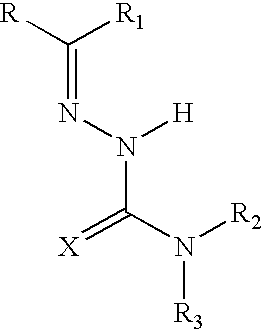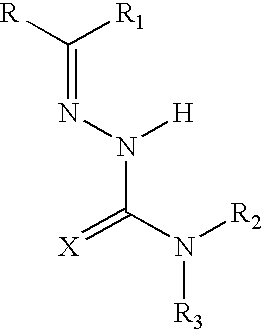Pharmaceutical compositions comprising semicarbazones and thiosemicarbazones and method for treating inflammatory, painful and febrile conditions and preventing signs and symptoms of inflammation
- Summary
- Abstract
- Description
- Claims
- Application Information
AI Technical Summary
Problems solved by technology
Method used
Image
Examples
example 1
Assessing the Effect of Semicarbazones, Thiosemicarbazones and Combinations on Motor Activities of Mice, Using Benzaldehyde Semicarbazone as a Non-Limiting Example
[0036]The effect of BS on motor activity of Swiss male mice (20-30 g) was evaluated in order to investigate whether inhibition of nociceptive behavior in animals treated with BS would be a result of a central depressive effect. Their motor activity was evaluated in a rotarod. A day before the experiment, the mice were trained in the apparatus. During the experiment, they were put in a rotarod (14 rpm) and the time they stayed in the apparatus was determined. One minute was the cut-off time. After basal measurements, the animals were treated with BS (10, 25 or 50 mg / kg, intraperitoneal or 100 or 200 mg / kg, oral). Dimethyl sulfoxide (DMSO) 25%+Tween 80 10% in saline was the vehicle used for intraperitoneal administration and carboxymethylcellulose 0.5%, a pharmaceutically acceptable excipient, was used for oral administratio...
example 2
Assessing the Effect of Semicarbazones, Thiosemicarbazones and Combinations on the Nociceptive Response Induced by Formaldehyde in Mice, Using Benzaldehyde Semicarbazone as a Non-Limiting Example
[0037]In the nociceptive response induced by formaldehyde (0.92%, 20 μL), the inflammatory stimulus is injected subcutaneously into the dorsum of the right hind paw of male Swiss mice. The time the animal spent licking its injected paw was determined from 0 to 5 min (first phase) and from 15 to 30 min (second phase) after formaldehyde injection.
[0038]Dimethyl sulfoxide (DMSO) 25%+Tween 80 10% in saline was the vehicle used for intraperitoneal administration and carboxymethylcellulose 0.5%, a pharmaceutically acceptable excipient, was used for oral administration. Thirty or 60 min after intraperitoneal or oral administration, respectively, formaldehyde was injected and the nociceptive behavior evaluated as described.
[0039]Only the dose of 50 mg / kg of BS, administered via the intraperitoneal r...
example 3
Assessing the Effect of Semicarbazones, Thiosemicarbazones and Combinations on Thermal and Mechanical Allodynia Induced by Carrageenan in Rats, Using Benzaldehyde Semicarbazone as a Non-Limiting Example
[0040]BS has also inhibited the nociceptive response in the model of thermal and mechanical allodynia induced by carrageenan in Wistar male rats (200-250 g). In the model of thermal allodynia, the latency for paw removal after application of a thermal stimulus is assessed in the Hargreaves apparatus (model 7370, Ugo Basile, Italy). In the model of mechanical allodynia, the frequency of paw withdrawal to a series of ten touches with a nylon filament to the plantar surface of the right hind paw is determined.
[0041]Dimethyl sulfoxide (DMSO) 25%+Tween 80 10% in saline was the vehicle used for intraperitoneal administration and carboxymethylcellulose 0.5%, a pharmaceutically acceptable excipient, was used for oral administration. Thirty or 60 min after intraperitoneal or oral administratio...
PUM
| Property | Measurement | Unit |
|---|---|---|
| Fraction | aaaaa | aaaaa |
| Concentration | aaaaa | aaaaa |
Abstract
Description
Claims
Application Information
 Login to View More
Login to View More - R&D
- Intellectual Property
- Life Sciences
- Materials
- Tech Scout
- Unparalleled Data Quality
- Higher Quality Content
- 60% Fewer Hallucinations
Browse by: Latest US Patents, China's latest patents, Technical Efficacy Thesaurus, Application Domain, Technology Topic, Popular Technical Reports.
© 2025 PatSnap. All rights reserved.Legal|Privacy policy|Modern Slavery Act Transparency Statement|Sitemap|About US| Contact US: help@patsnap.com


